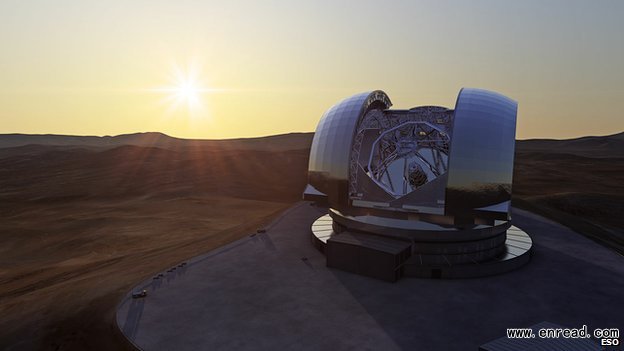|
  
- UID
- 86155
- 帖子
- 60350
- 积分
- 64892
- 学分
- 591606 个
- 金币
- 810 个
- 性别
- 男
- 在线时间
- 2779 小时

|
|
Construction of world's biggest optical telescope has been approved.
建设世界上最大的光学望远镜的计划已获批准。
The E-ELT would take advantage of the very arid conditions in Chile's Atacama desert
The European Extremely Large Telescope (E-ELT) will have a primary mirror some 40m in diameter, and will be built on top of a mountain in Chile.
Member states of the European Southern Observatory (Eso) organisation declared their support for the project on Monday at a meeting in Garching, Germany.
They have not yet, however, put all of the 1bn euros (£0.8bn) of financing in place.
That may be possible by December, at the organisation's next council meeting.
By then, Brazil should also have become the 15th full member of Eso, further spreading the E-ELT's cost and making it more affordable for all nations.
The telescope should be ready for use by about 2022, and will be one of the key astronomical facilities of 21st Century, complementing other huge observatories that will view the sky at different wavelengths of light.
Voting positions
The E-ELT will detect objects in the visible and near-infrared. Its 39.3m main mirror will be more than four times the width of today's best optical telescopes (antennas for radio telescopes are still very much bigger).
Its sensitivity and resolution should make it possible to image directly rocky planets beyond our Solar System.
The observatory should also be able to provide major insights into the nature of black holes, galaxy formation, the mysterious "dark matter" that pervades the Universe, and the even more mysterious "dark energy" which appears to be pushing the cosmos apart at an accelerating rate.
At the Garching meeting, six nations (Austria, the Czech Republic, Germany, the Netherlands, Sweden and Switzerland) were in a position to declare their full support to proceed with the project; four nations (Belgium, Finland, Italy, and the United Kingdom) declared their support pending approval from their governments; and the remaining four (Denmark, France, Portugal, Spain) said they continued to work towards full approval.
The commitments from two-thirds of the members are sufficient at this stage to permit Eso to proceed with the project.
Prof Isobel Hook is the UK E-ELT project scientist from the University of Oxford. She said Monday's decision was hugely exciting.
"We've all been working towards this moment for a long time, and this decision means we're now just a few years away from using this telescope," she told BBC News.
"The E-ELT's great size will give us much sharper images, provided we can correct for atmospheric turbulence(大气湍流) [which makes stars twinkle], and that will be part of the telescope's design. The E-ELT will also have a much larger collecting area than any telescope we have now. That combination of sharpness and collecting area is what will make it so powerful."
更多英语新闻 |
|